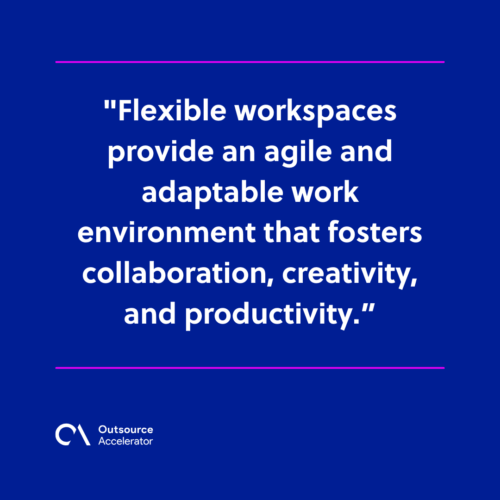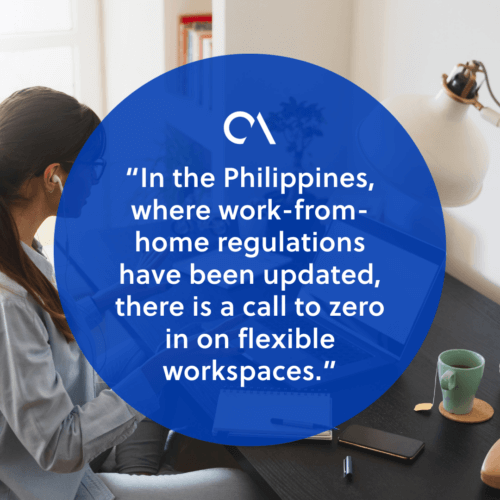Why your company should have flexible workspaces

Picture this: instead of the traditional cubicles and stuffy office spaces, there’s a dynamic and versatile work environment that caters to your employees’ unique preferences and needs.
That’s precisely what flexible workspaces offer. They are the key to creating a workplace that empowers your team, fosters collaboration, and boosts productivity.
According to Statista, flexible work environments are increasingly adopted in Europe, Asia, and North America. Almost two million people have worked in coworking spaces worldwide since 2020.
So, what exactly are flexible workspaces, and why should your company jump on the bandwagon? Let’s explore!
What is a flexible workspace?
A flexible workspace or a flexible office space is a physical environment that allows employees to work in various settings based on their individual needs and preferences.
Gone are the days of rigid cubicles and fixed offices. Flexible workspaces provide an agile and adaptable work environment that fosters collaboration, creativity, and productivity.

Elements of a flexible workspace
There are some basic aspects found in flexible spaces that aim to promote versatility and collaboration:
- Open-plan designs. Flexible workspaces often feature open-plan layouts. They eliminate physical walls between workers and promote free-flowing collaboration between departments.
- Quiet areas. To counteract the increased ambient noise caused by open-plan designs, flexible workspaces designate quiet areas where employees can focus on tasks without interruption.
- Adaptable workstations. Flexible office spaces incorporate non-traditional styles of workstations, such as standing desks in common areas. This encourages employees to move around and utilize the space in different ways.
- Shared amenities. Rather than each individual storing necessary items on and around their desks, flexible workspaces centralize resources and make them accessible to everyone. These shared amenities include office supplies, printers, conference rooms, and informal common areas.
Types of flexible workspaces
Flexible workspaces come in various forms, catering to different needs and preferences. Here are some common types:
Open offices
Open offices are designed to foster collaboration by removing physical barriers and creating a more accessible and communal environment.
They encourage interaction and impromptu conversations among team members while promoting a sense of transparency and equality within the workplace.
Coworking spaces
Coworking spaces are shared by individuals or small teams from different companies. This can foster networking opportunities and collaboration.
Hot desks
Hot desks are unassigned workspaces available on a first-come, first-served basis. Employees can choose any available desk each day.
This arrangement promotes flexibility and encourages interaction between different teams.
Private offices
Companies can also lease private and dedicated office spaces. It provides workers with a separate and customizable environment while enjoying the benefits of a flexible workspace.
Virtual offices
A virtual office allows businesses to have a professional mailing address, phone answering services, and access to meeting rooms on an as-needed basis.
This option is particularly useful for remote teams or those who operate mostly online. In the Philippines, where work-from-home regulations have been updated, there is a call to zero in on flexible workspaces.

Benefits of using flexible workspaces
Using flexible workspaces poses a number of advantages, such as:
Boosted productivity
Flexible workspaces empower employees to tailor their work environment to suit their needs.
Whether it’s a quiet space for focused tasks or a collaborative area for team projects, the freedom to choose enhances productivity.
According to Apollo Technical, most workers admit to being more productive at home because of the lack of distractions and the increased comfort it provides.
Enhanced collaboration
Open-plan layouts and shared amenities encourage spontaneous collaboration and interaction among different team employees, fostering creativity and innovation.
Cost-effectiveness
Flexible workspaces allow companies to optimize office layouts and maximize available space.
With employees utilizing the office flexibly, businesses can reduce costs by minimizing unused or underutilized areas.
Better work-life balance
Flexible office spaces give employees the freedom to work when and where they are most productive.
This flexibility allows them to manage personal responsibilities better, avoid rush-hour commutes, and achieve a healthier work-life balance.
Scalability and adaptability
Flexible workspaces can easily accommodate changing business needs. Whether a company is expanding or downsizing, these places can be easily adjusted to accommodate teams of different sizes and adapt to evolving requirements.
How to introduce flexible workspaces
Implementing flexible workspaces requires careful planning and consideration. Here are some steps to successfully introduce workers into these arrangements:
- Assess the needs. Take note of the unique needs and preferences of your team members. This can be done through surveys or discussions to gauge their interest in flexible work options.
- Design the space. Create a flexible workspace layout that caters to different work styles. Incorporate a variety of work areas, such as collaborative zones, quiet areas, and relaxation corners, to accommodate various tasks and preferences.
- Establish guidelines. Develop clear guidelines and policies regarding the use of flexible office spaces. Communicate these guidelines effectively to ensure everyone understands the expectations and benefits of the new workspace model.
- Provide technology support. Ensure that the workspace is equipped with the necessary tech infrastructure. This includes accessible outlets for charging devices and a reliable wireless network to support mobile work.
- Foster a culture of trust. Encourage open communication, recognize achievements, and focus on results rather than micromanaging. Employees who feel trusted are more likely to embrace and excel in flexible work environments.
Flexible workspaces as the new normal
The shift towards flexible workspaces is not a temporary response to external factors — it’s a reflection of evolving work philosophies.

Companies that embrace this position themselves for long-term success. It’s about recognizing that work is what you do, not where you go.
Flexible office spaces are not just a perk for employees — they are a strategic decision that can revolutionize how your company operates.
By grasping the idea of flexible workspaces and leveraging it strategically, your company can thrive in this new era of work, where adaptability is the key to success.







 Independent
Independent




